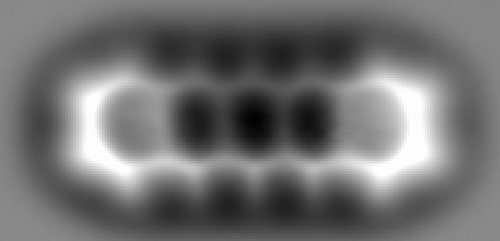
At first glance, this may seem to be a rather unassuming image. A neutral gray background disrupted by a patterned spattering of white lines, which themselves are broken up by a couple of dark spherical shapes. To understand the significance of this image one must really ‘look’ at it and do a little bit of reading. Contrary to our initial reactions, this image is truly remarkable.
The picture above is an actual photo of the atomic bonds of a pentacene molecule. Yes you read that right, the atomic bonds. The molecule above is a whopping 1.4 nanometers long. For those of you who have not taken a chemistry class in the recent past, one meter is equal to 1 billion nanometers. When you begin to consider how incredibly small that molecule is, it becomes exceptionally easy to appreciate what a landmark image this really is. It’s no wonder that it took the mad scientists at IBM 20 hours to capture this single image. What’s more is that they had to ensure that the molecule stay perfectly still during the exposure.
For the full article head on over to Gizmodo.
![[del.icio.us]](http://thephotoplayground.com/wp-content/plugins/bookmarkify/delicious.png)
![[Digg]](http://thephotoplayground.com/wp-content/plugins/bookmarkify/digg.png)
![[Facebook]](http://thephotoplayground.com/wp-content/plugins/bookmarkify/facebook.png)
![[Furl]](http://thephotoplayground.com/wp-content/plugins/bookmarkify/furl.png)
![[Google]](http://thephotoplayground.com/wp-content/plugins/bookmarkify/google.png)
![[LinkedIn]](http://thephotoplayground.com/wp-content/plugins/bookmarkify/linkedin.png)
![[Reddit]](http://thephotoplayground.com/wp-content/plugins/bookmarkify/reddit.png)
![[StumbleUpon]](http://thephotoplayground.com/wp-content/plugins/bookmarkify/stumbleupon.png)
![[Technorati]](http://thephotoplayground.com/wp-content/plugins/bookmarkify/technorati.png)
![[Twitter]](http://thephotoplayground.com/wp-content/plugins/bookmarkify/twitter.png)
![[Email]](http://thephotoplayground.com/wp-content/plugins/bookmarkify/email.png)





















I don’t think that technology is that far off. I wouldn’t be surprised If in a year or two the technology is adapted to photograph in three dimensions. At the very least they will be able to create three dimensional digital models from a set of stills. The technology for building digital three dimensional models is already available and is quite good. The next step for these scientists would be to create a set of sensors that can make an exposure simultaneously from different vantage points. So long as you know the coordinates of the sensors creating the model should be relatively easy. They could probably make some pretty gnarly physical models by using some of those high end 3D printers as well.
Excellent find Sean! I still find this photo hauntingly clear. I never imagined we’d be able to “see” single molecules with this type of resolution. It will probably quite a while before we can use similar technology to visualize more complex molecules (pentacene is flat, while most biologically or synthetically interesting organic molecules fill 3D space), but this is a step in the right direction.